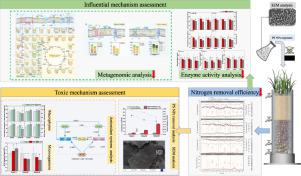Water Research ( IF 11.4 ) Pub Date : 2021-07-10 , DOI: 10.1016/j.watres.2021.117420 Yixuan Ma 1 , Juan Huang 1 , Tingwei Han 1 , Chunni Yan 1 , Chong Cao 1 , Meifang Cao 1

|
The widespread use of nanoplastics inevitably leads to their increasing emission into constructed wetlands (CWs). However, little is known about the impacts of nanoplastics on nitrogen transformation in CWs. In this study, the influence of polystyrene nanoparticles (PS NPs), one of the most widely used plastics, on the nitrogen transformation in CWs was comprehensively investigated, and the influential and toxic mechanism was evaluated through metagenomic analysis (DNA level) and key enzyme activities (protein level) related to N-transformation metabolism and antioxidant systems. The results showed that over 97% of PS NPs were retained in CWs, and the biofilm of sand was the main sink of PS NPs. Exposure to 1 and 10 mg/L PS NPs suppressed the nitrogen transformation, causing a certain degree of inhibition in TN removal, especially in the relatively short term of the exposure experiment (p < 0.05). At the protein level, 1 and 10 mg/L PS NPs negatively affect enzyme activities involved in denitrification (nitrate reductase and nitrite reductase) and electron transport system activity (ETSA). In contrast, 10 mg/L of PS NPs significantly suppressed the activities of nitrifying enzymes (ammonia monooxygenase, hydroxylamine dehydrogenase and nitrite oxidoreductase), whereas 1 mg/L PS NPs showed no impacts on nitrifying enzymes. Metagenomic analysis further certified that PS NPs restrained the relative abundances of genes involved in nitrogen transformation including nitrification and denitrification biochemical metabolisms (the electron production, electron transport and electron consumption processes). It also indicated that PS NPs could affect nitrogen transformation by reducing the abundance of genes for electron donor and ATP production involved in carbon metabolism (glycolysis and tricarboxylic acid cycle metabolism). In our study, the potential toxic mechanisms of PS NPs attributed to over production of reactive oxygen species and variations of antioxidant systems in macrophytes and microorganisms. These results provided valuable information for evaluating the impacts of PS NPs on CWs and arouse more attention to their impacts on the global geochemical nitrogen and carbon cycles.
中文翻译:

综合宏基因组和酶活性分析揭示了聚苯乙烯纳米粒子对人工湿地氮转化的负面影响和潜在毒性机制
纳米塑料的广泛使用不可避免地导致它们向人工湿地 (CW) 的排放增加。然而,关于纳米塑料对 CW 中氮转化的影响知之甚少。本研究综合研究了应用最广泛的塑料之一聚苯乙烯纳米粒子(PS NPs)对 CWs 中氮转化的影响,并通过宏基因组分析(DNA 水平)和关键酶评估其影响和毒性机制。与 N-转化代谢和抗氧化系统相关的活性(蛋白质水平)。结果表明,97% 以上的 PS NPs 保留在 CWs 中,沙子生物膜是 PS NPs 的主要汇。暴露于 1 和 10 mg/L PS NPs 抑制了氮转化,对 TN 去除造成一定程度的抑制,磷< 0.05)。在蛋白质水平上,1 和 10 mg/L PS NPs 对反硝化作用(硝酸还原酶和亚硝酸还原酶)和电子传递系统活性 (ETSA) 中涉及的酶活性产生负面影响。相比之下,10 mg/L 的 PS NPs 显着抑制硝化酶(氨单加氧酶、羟胺脱氢酶和亚硝酸盐氧化还原酶)的活性,而 1 mg/L 的 PS NPs 对硝化酶没有影响。宏基因组分析进一步证明,PS NPs 抑制了参与氮转化的基因的相对丰度,包括硝化和反硝化生化代谢(电子产生、电子传递和电子消耗过程)。它还表明,PS NPs 可以通过减少参与碳代谢(糖酵解和三羧酸循环代谢)的电子供体和 ATP 产生的基因丰度来影响氮转化。在我们的研究中,PS NPs 的潜在毒性机制归因于大型植物和微生物中活性氧的过度产生和抗氧化系统的变化。这些结果为评估 PS NPs 对 CWs 的影响提供了有价值的信息,并引起人们对它们对全球地球化学氮和碳循环的影响的更多关注。PS NPs 的潜在毒性机制归因于大型植物和微生物中活性氧的过度产生和抗氧化系统的变化。这些结果为评估 PS NPs 对 CWs 的影响提供了有价值的信息,并引起人们对它们对全球地球化学氮和碳循环的影响的更多关注。PS NPs 的潜在毒性机制归因于大型植物和微生物中活性氧的过度产生和抗氧化系统的变化。这些结果为评估 PS NPs 对 CWs 的影响提供了有价值的信息,并引起人们对它们对全球地球化学氮和碳循环的影响的更多关注。











































 京公网安备 11010802027423号
京公网安备 11010802027423号